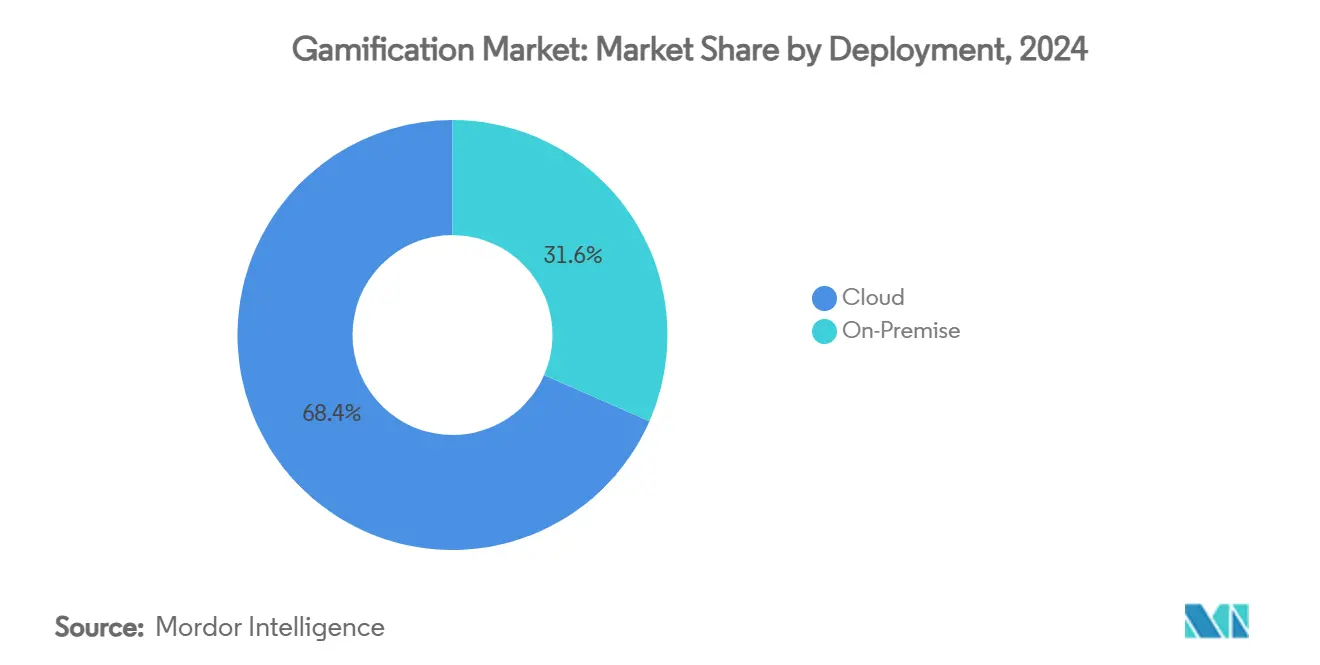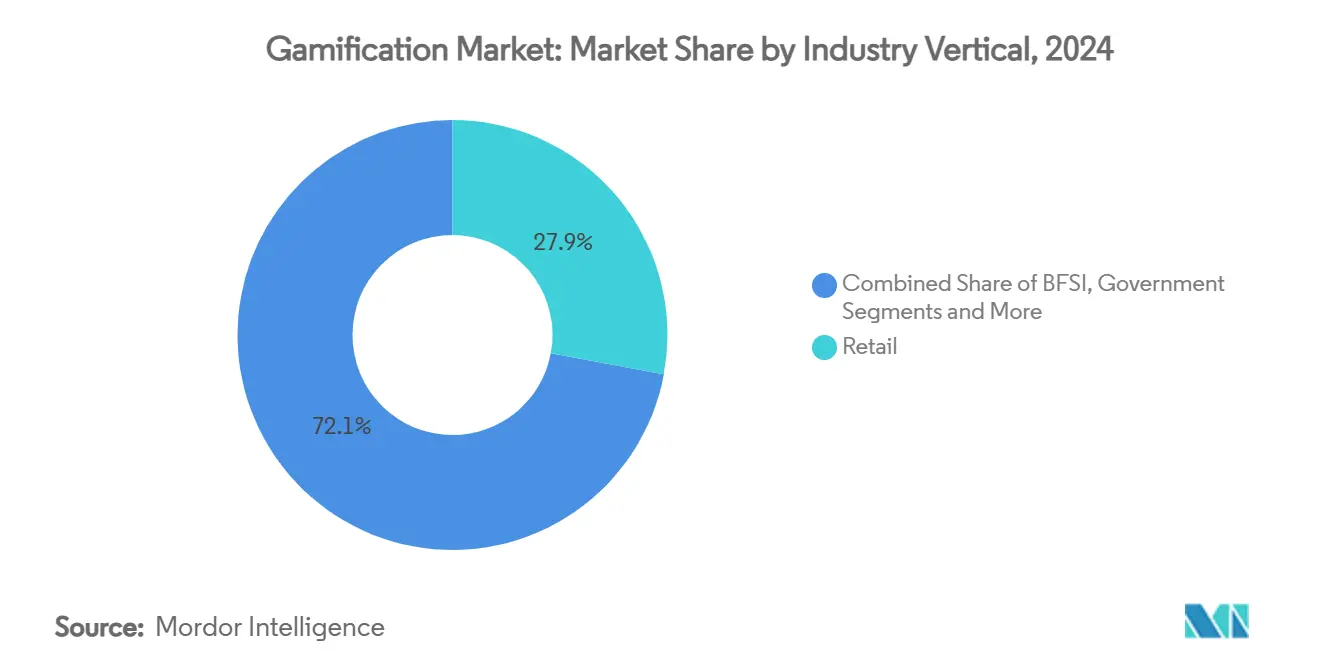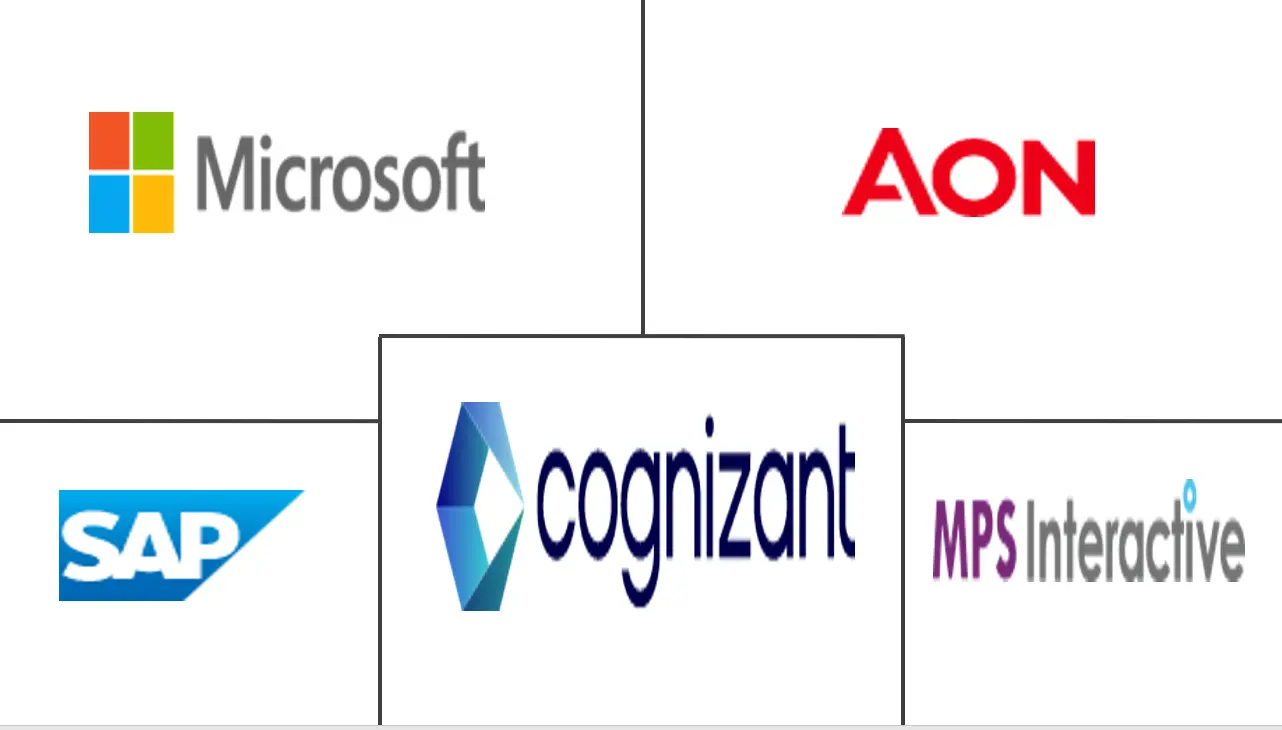
Gamification Market Analysis by Mordor Intelligence
The gamification market size is valued at USD 29.11 billion in 2025 and is forecast to reach USD 92.51 billion by 2030, advancing at a 26.02% CAGR over the period. Cloud-based deployments already capture the majority of spend and, by delivering real-time analytics across distributed teams, underpin much of the current expansion. Large enterprises still account for the bulk of revenue, yet small and medium enterprises (SMEs) are scaling faster as low-code platforms lower adoption costs. Retail loyalty schemes remain the single-largest application, but employee-centric programs—particularly micro-learning initiatives—are recording the strongest uptake. Regionally, North America holds the lead, although Asia-Pacific’s mobile-first business culture is shifting the center of gravity toward emerging digital economies. Competitive intensity stays high because established software vendors and specialist start-ups target the same white-space opportunities in regulated verticals.
Key Report Takeaways
- By deployment, cloud-based solutions controlled 68.43% revenue share in 2024; the segment is projected to expand at a 27.58% CAGR through 2030.
- By organization size, large enterprises held 57.89% of the gamification market share in 2024, while SMEs are forecast to grow at a 28.67% CAGR to 2030.
- By industry vertical, retail captured 27.93% share of the gamification market size in 2024, and IT & Telecom is advancing at a 29.34% CAGR through 2030.
- By application, marketing & sales represented 25.67% of 2024 revenue; HR & training is projected to rise at a 28.78% CAGR to 2030.
- By geography, North America accounted for 39.28% of 2024 spend, yet Asia-Pacific leads future growth with a 29.91% CAGR to 2030.
Global Gamification Market Trends and Insights
Drivers Impact Analysis
| Driver | (~) % Impact on CAGR Forecast | Geographic Relevance | Impact Timeline |
|---|---|---|---|
| Surge in cloud-first digital-workplace roll-outs | +4.2% | Global, led by Asia-Pacific and North America | Medium term (2-4 years) |
| Proliferation of low-code gamification platforms | +3.8% | Global, SME-dense regions | Short term (≤2 years) |
| Retail loyalty wars escalating points and badges usage | +3.1% | North America and core EU markets | Short term (≤2 years) |
| Smartphone-centric micro-learning for frontline staff | +2.9% | Asia-Pacific core, spill-over to MEA | Medium term (2-4 years) |
| Privacy-preserving engagement analytics | +2.4% | EU and North America regulatory zones | Long term (≥4 years) |
| Gamified CBDC pilots by central banks | +1.8% | Asia-Pacific experimental markets, Thailand leading | Long term (≥4 years) |
| Source: Mordor Intelligence | |||
Surge in Cloud-First Digital-Workplace Roll-Outs
Enterprises accelerating cloud migration need engagement tools that function natively across hybrid teams. Microsoft Power Apps embeds game mechanics directly into workflows, cutting rollout times from months to weeks [1]Microsoft Corporation, “Microsoft Power Apps – Build Apps with AI,” microsoft.com. Cloud-hosted platforms generate the 27.58% CAGR forecast because they consolidate data streams and push real-time leaderboards to any device. Organizations integrating gamification with existing cloud infrastructure report up to 90% productivity improvement in remote work settings. The cost advantages of subscription licensing further accelerate adoption. As IT departments rationalize on-premise assets, cloud-native vendors gain a structural advantage that is unlikely to reverse over the outlook period.
Proliferation of Low-Code Gamification Platforms
Drag-and-drop development is democratizing the design of engagement experiences. SAP Build allows citizen developers to insert challenges, badges, and rewards into core business processes without writing code, trimming development spend by 70% against bespoke projects. The accessibility expands the total addressable base beyond large enterprises to SMEs that lacked technical resources. Platform vendors report a surge in templates focused on sales contests and onboarding missions, indicating mainstream business adoption. Because low-code stacks connect directly to SaaS ecosystems, they also shorten proof-of-value cycles, a key procurement hurdle for smaller firms. The structural decline in custom development aligns with the segment’s 28.67% SME CAGR.
Retail Loyalty Wars Escalating Points and Badges Adoption
Heavy competition in mature consumer markets forces retailers to rely on immersive loyalty frameworks instead of price cuts. Starbucks attributes 40% of revenue to its tier-based star accumulation model, validating tangible returns from gamified rewards. Sephora’s challenge-driven program added more than 2 million members by focusing on goal-oriented shopping journeys. However, point inflation risks user fatigue, nudging brands toward experiential perks and social-sharing mechanics. Vendors offering dynamic reward engines are therefore well-positioned. The intensified loyalty arms race supplies steady demand for advanced engagement analytics capable of segment-level personalization.
Smartphone-Centric Micro-Learning for Frontline Workforces
Front-of-house employees often lack desk access, making mobile the primary channel for upskilling. Three UK achieved higher retention by deploying 3D simulation games in two-minute bursts, timed to retail traffic lulls. HR teams cite 60% boosts in training completion when lessons are gamified and mobile-first. The result is a 28.78% CAGR in HR & training applications. Content designers increasingly integrate adaptive scoring to maintain skill freshness, embedding learning in day-to-day workflows. Because smartphones already house productivity and point-of-sale apps, incremental rollout costs stay low, fueling rapid scalability in service-heavy industries.
Restraint Impact Analysis
| Restraint | (~) % Impact on CAGR Forecast | Geographic Relevance | Impact Timeline |
|---|---|---|---|
| Poorly-designed programs deliver negative ROI | −2.8% | Global, early-adopter markets | Short term (≤2 years) |
| Inter-platform data-ownership disputes | −1.9% | EU and North America | Medium term (2-4 years) |
| Antigaming clauses in sector-specific compliance | −1.6% | North America and EU | Long term (≥4 years) |
| Accessibility lawsuits on non-inclusive mechanics | −1.2% | North America litigation-prone | Medium term (2-4 years) |
| Source: Mordor Intelligence | |||
Poorly-Designed Programs Deliver Negative ROI
Superficial point-and-badge deployments risk disengagement and budget waste. Versus Systems’ client roster fell from 16 to 5 in 2023 after lackluster implementations failed to sustain user interest, exemplifying backlash against gimmicky rollouts. Enterprises now demand business-outcome metrics, such as sales lift or error-rate reduction, before green-lighting new projects. This scrutiny lengthens sales cycles and forces vendors to provide stronger consultative support. Implementation missteps in early-adopter sectors also create caution among laggards, dampening near-term spend. Vendors that neglect instructional design and behavioral science risk reputational damage that can reverberate across the wider gamification market.
Antigaming Clauses in Sector-Specific Compliance (HIPAA, MiFID-II)
Regulated industries face strict conduct and privacy obligations that conflict with incentivized behavior loops. The U.S. Federal Trade Commission levied USD 7.8 million in penalties on a mental-health app for HIPAA violations, spotlighting the financial hazards of non-compliance. In financial services, MiFID-II mandates granular audit trails, complicating reward structures that steer customer decisions. The ambiguity deters procurement teams in healthcare and banking, two high-value verticals. Specialized providers that embed consent management and audit logging gain a strategic edge, but development costs increase, pressuring margins. Until regulators issue clearer guidelines, adoption in these segments will lag non-regulated domains.
Segment Analysis
By Deployment: Cloud Infrastructure Drives Platform Consolidation
Cloud solutions accounted for 68.43% of 2024 revenue, and their share of the gamification market size is projected to climb further, given a 27.58% CAGR to 2030. Real-time telemetry, seamless updates, and elastic storage underpin the preference, while maturing security certifications sway even conservative sectors. On-premise packages remain relevant where data sovereignty is paramount, yet shrinking IT budgets and rising cyber-insurance premiums tilt cost–benefit equations toward managed hosting.
Rapid iteration cycles, achieved through continuous delivery pipelines, let cloud vendors fine-tune achievement algorithms and A/B-test narratives without client-side patches. Enterprises report 37% productivity gains when advanced analytics recommend personalized challenges in real time. Hybrid rollouts serve as a transitional choice, allowing sensitive data to stay on site while engagement logic resides in the cloud. Over the forecast, migration to public-cloud stacks is expected to standardize integration patterns, reducing total cost of ownership and consolidating vendor footprints.

By Organization Size: SME Adoption Accelerates Through Accessible Platforms
Large enterprises contributed 57.89% to 2024 revenue, reflecting deep budgets and complex integration needs. In contrast, SMEs represent the fastest-growing slice of the gamification market, expanding at 28.67% CAGR. Freemium pricing, template libraries, and pay-as-you-grow architectures lower entry barriers for smaller firms.
SMEs typically target narrow pain points—motivating a sales pod or onboarding seasonal staff—allowing them to demonstrate ROI within weeks. Government digitalization grants in markets such as Singapore further stimulate uptake by offsetting subscription fees. Feature parity is narrowing because cloud platforms offer enterprise-grade identity management at mass-market price tiers. As a result, mid-market buyers increasingly insist on SOC 2 compliance and single-sign-on, forcing vendors to harden security roadmaps while keeping price elasticity.
By Industry Vertical: IT and Telecom Disrupts Retail Leadership
Retail held 27.93% share of the gamification market in 2024, fueled by entrenched loyalty ecosystems. Yet IT and Telecom is predicted to grow at a 29.34% CAGR, reflecting new-hire ramp-up needs and customer-churn pressures. Service providers use game loops to cut mean-time-to-competency for complex product lines and to reward self-service troubleshooting.
Banking institutions illustrate diversification: First United Bank and Trust recorded a 53% user-adoption rate and a 20-fold spike in savings-account openings through its gamified mobile guidance platform[2]Finotta Inc., “First United Bank and Trust Case Study,” finotta.com. Healthcare hesitates because of data-protection liabilities, though patient-adherence pilots in diabetes management show early promise. Manufacturing and logistics now explore game mechanics for safety drills and route optimization, broadening vendor addressable markets beyond traditional consumer-facing segments.

Note: Segment shares of all individual segments available upon report purchase
By Application: HR and Training Overtakes Marketing Dominance
Marketing and sales platforms owned 25.67% share in 2024, but HR-focused deployments are forecast to grow at 28.78% CAGR, gradually eclipsing outward-facing use cases. Economic uncertainty drives executives to invest in productivity levers that yield direct cost efficiencies.
Gamified learning modules raise compliance-training completion by 60% compared with slide-based courses. Performance-management dashboards that convert KPIs into quests are gaining favor as organizations move toward continuous feedback cultures. Beyond core HR, product-innovation sprints and customer-support gamification deliver collaborative problem-solving frameworks. The broadening application slate signals a shift from isolated campaigns toward enterprise-wide engagement strategy.
Geography Analysis
North America generated 39.28% of 2024 revenue, benefitting from early SaaS adoption and a deep vendor ecosystem. Corporations prioritize integrations with HRIS and CRM suites, leading to rapid feature rollouts that drive wallet share. Federal accessibility litigation risk motivates platforms to invest in WCAG-compliant design, raising quality thresholds for all suppliers.
Asia-Pacific records the highest regional CAGR at 29.91%, powered by mobile-first working patterns and government-sponsored digital-skills programs. Singapore’s public-service gamification initiatives validate efficacy and encourage private-sector replication. Thailand’s digital-wallet scheme experiments with gamified Central Bank Digital Currency incentives, signaling policy-level endorsement. Companies capitalize by shipping lightweight applications optimized for low-latency 5G networks, accelerating uptake in populous markets such as India and Indonesia.
Europe shows steady demand despite stringent privacy rules. GDPR obligations spur innovation in differential-privacy analytics that anonymize reward data. Vendors with in-house legal teams gain an edge when customizing consent flows for financial institutions subject to MiFID-II. South America and the Middle East and Africa trail in absolute dollars but benefit from growing smartphone penetration, making cloud-hosted, mobile-native solutions the default choice. Localization—both linguistic and cultural—remains a decisive factor in conversion rates across these emerging territories.

Competitive Landscape
The supplier base remains fragmented, with no vendor exceeding a double-digit slice of overall revenue, positioning the gamification market as an open arena for specialization. Microsoft embeds achievement layers in its Power Platform, eroding demand for standalone products unless they deliver niche functionality[3]Microsoft Corporation, “Power Apps and Power Automate,” microsoft.com. SAP, Oracle, and Salesforce race to match these capabilities, prompting a wave of acquisitions targeting analytics engines and behavioral-science intellectual property.
Specialist platforms compete on depth rather than breadth, offering configurable rule engines and AI-driven personalization. Patent filings, such as Niantic’s geo-based content recommendations, underline efforts to protect algorithmic differentiation. Emerging entrants leverage blockchain to tokenize rewards, positioning against fraud and offering cross-program interchangeability. Investors focus on evidence of sustained daily active users over vanity leaderboard metrics, shifting valuation criteria toward retention economics.
Industry-specific white-space remains, especially in healthcare where HIPAA compliance gates entry. Vendors that hard-wire audit trails and encryption into system architecture win pilot contracts ahead of broader rollouts. Partnerships with LMS, HRIS, and digital-experience-platform providers continue to define go-to-market speed. Despite consolidation rumors, abundant venture funding suggests that start-ups can still differentiate through vertical depth and real-time sentiment analytics.
Gamification Industry Leaders
-
Cognizant Technology Solution Corp.
-
MPS Interactive Systems Limited
-
Microsoft Corporation
-
SAP SE
-
Aon plc
- *Disclaimer: Major Players sorted in no particular order

Recent Industry Developments
- March 2025: Duolingo reported revenue of USD 811.2 million with 39% growth, demonstrating sustained expansion for gamified learning platforms as language education demand rises globally.
- February 2025: Roblox achieved USD 3.6 billion revenue in 2024 with 29% growth, highlighting platform-based gamification success in entertainment and education sectors.
- January 2025: McDonald’s UK gamified till-training program generated GBP 23.7 million (USD 30.1 million) additional revenue across 1,300 restaurants through improved service efficiency and reduced training costs.
- December 2024: European video-games industry reached EUR 19 billion (USD 20.5 billion) turnover, reflecting regulatory-framework maturation that supports enterprise gamification adoption across EU markets.
Global Gamification Market Report Scope
Gamification uses the human tendency to influence one's thinking process by engaging users to become effective problem solvers, even in the real world. The study aims to analyze and understand the gamification market's current growth, opportunities, and challenges.
The scope of market analysis is segmented by deployment (on-premise and on-cloud), size (small and medium enterprises and large enterprises), platform (open platform and closed/enterprise platform), end-user vertical (retail, banking, government, healthcare, education and research, IT and telecom, and other end-user verticals), and geography (North America, Europe, Asia-Pacific, Latin America, and Middle East and Africa). The market sizes and forecasts are provided in USD for all the above segments.
| On-Premise |
| Cloud |
| Large Enterprises |
| Small and Medium Enterprises (SMEs) |
| Retail |
| BFSI |
| Government |
| Healthcare |
| Education and Research |
| IT and Telecom |
| Others |
| Marketing and Sales |
| HR and Training |
| Product Development and Innovation |
| Customer Support and Experience |
| Others |
| North America | United States | |
| Canada | ||
| Mexico | ||
| South America | Brazil | |
| Argentina | ||
| Colombia | ||
| Rest of South America | ||
| Europe | Germany | |
| United Kingdom | ||
| France | ||
| Italy | ||
| Spain | ||
| Russia | ||
| Netherlands | ||
| Rest of Europe | ||
| Asia-Pacific | China | |
| Japan | ||
| South Korea | ||
| India | ||
| Australia | ||
| Singapore | ||
| Rest of Asia-Pacific | ||
| Middle East and Africa | Middle East | Saudi Arabia |
| United Arab Emirates | ||
| Rest of Middle East | ||
| Africa | South Africa | |
| Egypt | ||
| Rest of Africa | ||
| By Deployment | On-Premise | ||
| Cloud | |||
| By Organization Size | Large Enterprises | ||
| Small and Medium Enterprises (SMEs) | |||
| By Industry Vertical | Retail | ||
| BFSI | |||
| Government | |||
| Healthcare | |||
| Education and Research | |||
| IT and Telecom | |||
| Others | |||
| By Application | Marketing and Sales | ||
| HR and Training | |||
| Product Development and Innovation | |||
| Customer Support and Experience | |||
| Others | |||
| By Geography | North America | United States | |
| Canada | |||
| Mexico | |||
| South America | Brazil | ||
| Argentina | |||
| Colombia | |||
| Rest of South America | |||
| Europe | Germany | ||
| United Kingdom | |||
| France | |||
| Italy | |||
| Spain | |||
| Russia | |||
| Netherlands | |||
| Rest of Europe | |||
| Asia-Pacific | China | ||
| Japan | |||
| South Korea | |||
| India | |||
| Australia | |||
| Singapore | |||
| Rest of Asia-Pacific | |||
| Middle East and Africa | Middle East | Saudi Arabia | |
| United Arab Emirates | |||
| Rest of Middle East | |||
| Africa | South Africa | ||
| Egypt | |||
| Rest of Africa | |||
Key Questions Answered in the Report
What is the current value of the gamification market?
The gamification market size is USD 29.11 billion in 2025.
How fast is global demand growing?
Revenue is forecast to rise at a 26.02% CAGR between 2025 and 2030.
Which deployment model holds the lion’s share?
Cloud-based platforms capture 68.43% of 2024 revenue and continue to expand faster than on-premise solutions.
Which region will add the most new spending by 2030?
Asia-Pacific leads growth with a 29.91% CAGR, driven by mobile-first enterprise strategies and supportive government programs.
What is the leading enterprise application?
HR and training deployments are now the fastest-growing use case, driven by the need to upskill distributed workforces.
Page last updated on:



